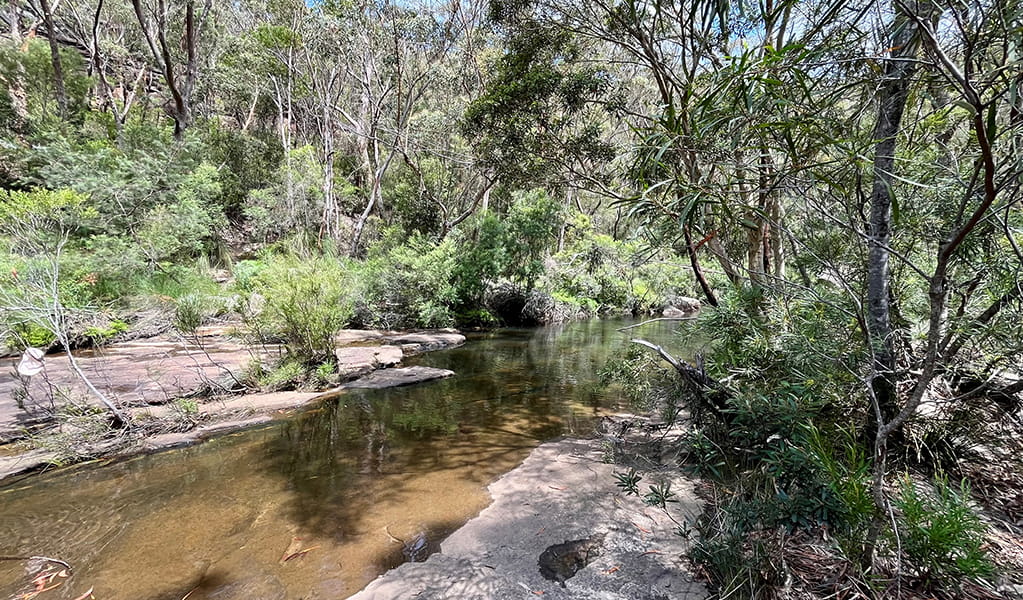Mirang Pool picnic area
Heathcote National Park
Overview
Go on an adventure to Mirang Pool picnic area in Heathcote National Park, just 45 mins from Sydney. After hiking along the trails, cool off at this secluded spot by paddling in the waterhole.
- Type
- Picnic areas
- Accessibility
- No wheelchair access
- What to
bring - Clothes for all weather conditions, drinking water, hat, snacks, sunscreen, sturdy shoes
- Please note
- There are no toilets, drinking water, rubbish bins or picnic tables. Please take your rubbish with you.
- The rocks can be extremely slippery, take care when walking through the shallow water.
- Please swim cautiously and never dive into a waterhole as there are submerged logs and branches that you cannot see.
- Camping is not permitted here.
Mirang Pool picnic area is at the northern end of Heathcote National Park. It's pretty but remote with no vehicle access and no facilities, so you'll need to carry everything in and out with you, including drinking water.
If you park at the end of Oliver Street, it's a 2km walk easily done in 30 mins. The hike from Heathcote train station takes 45 mins. To get there, go to the end of Oliver Street then take Goburra track which is steep in parts and requires some rock scrambling. On reaching Pipeline trail, turn left and keep walking until you see the blue signpost for Mirang Pool at the top of the stairs.
Enjoy a well-deserved paddle in Mirang Pool to cool off after your hike, then unpack your picnic spread. Afterwards, lie back and relax in the soft, sandy patches between the trees, gymea lillies and rock platforms. Or explore further, and walk or cycle to Battery Causeway picnic area just over a kilometre away.
Indulge in an authentic experience of the Australian bush less than an hour's hike from shops and a train station.
Nearby
-

Battery Causeway picnic area
Battery Causeway picnic area is in Sydney’s Heathcote National Park. It’s a peaceful rest stop along Pipeline trail or Bullawaring track, near Lake Eckersley picnic area.
Local alerts
For the latest updates on fires, closures and other alerts in this area, see https://www.nationalparks.nsw.gov.au/things-to-do/picnic-areas/mirang-pool-picnic-area/local-alerts
General enquiries
- National Parks Contact Centre
- 7am to 7pm daily
- 1300 072 757 (13000 PARKS) for the cost of a local call within Australia excluding mobiles
- parks.info@environment.nsw.gov.au
Park info
- in Heathcote National Park in the Sydney and surrounds and South Coast regions
Heathcote National Park is open sunrise to sunset but may have to close at times due to poor weather or fire danger.
Visitor info
All the practical information you need to know about the Mirang Pool picnic area.
Getting there and parking
Get driving directions
Mirang Pool picnic area is in Heathcote National Park.
There's no vehicle access. It can only be accessed by walking and you will need to carry everything in, and back out again.
The hike there from Heathcote train station is almost 3km and takes about 45 mins.
If you park at the end of Oliver Street it's a 2km walk easily done in 30 mins.
To get there from Heathcote train station:
- Take Oliver Street to the very end which is 900m and takes about 15 mins.
- At the end of Oliver Street take Goburra track which is steep in parts and requires some rock scrambling.
- On reaching Pipeline trail, turn left and keep walking until you see the blue signpost for Mirang Pool at the top of the stairs.
Park entry points
- Goburra walking track via Oliver Street, Heathcote
- Mirang fire trail, Heathcote
Parking
There is no vehicle access to the picnic area.
- Parking is available at the western end of Oliver Street in Heathcote.
- Limited parking is also available by the gate leading to Mirang fire trail.
By bike
If you are an experienced mountain bike rider, you can reach Mirang Pool picnic area from Pipeline fire trail. Or, cycle along Mirang fire trail, then turn right onto Pipeline trail.
By public transport
You can get a train to Heathcote Station from Town Hall or Central in Sydney. The hike from Heathcote train station to Mirang Pool is almost 3km and takes 45 mins.
Best times to visit
Mirang Pool picnic area is an exceptional place to visit all year round.
Autumn
Autumn is a great time to visit because the hike down to Mirang Pool and back out is much nicer when the temperatures cool.
Spring
Visit Mirang Pool picnic area in Spring to see blooming gymea lilies give a scarlet glow to the gullies.
Summer
Take a welcome dip in Mirang Pool on a hot summer day, or just paddle in the shallow waters to cool off.
Facilities
Mirang Pool is a remote picnic area. There are no facilities, rubbish bins, toilets or drinking water. Please take all rubbish with you when leaving.
Maps and downloads
Accessibility
Disability access level - no wheelchair access
Prohibited
Camp fires and solid fuel burners
Camping
Cycling
- Trail bikes are not permitted to be ridden beyond the blue sign on Pipeline trail.
- To prevent erosion and conserve the natural beauty of this place, please do not ride your bike at Mirang Pool.
Pets
Pets and domestic animals (other than certified assistance animals) are not permitted. Find out which regional parks allow dog walking and see the pets in parks policy for more information.
Smoking
NSW national parks are no smoking areas.
Learn more
Mirang Pool picnic area is in Heathcote National Park. Here are just some of the reasons why this park is special:
A long and varied history
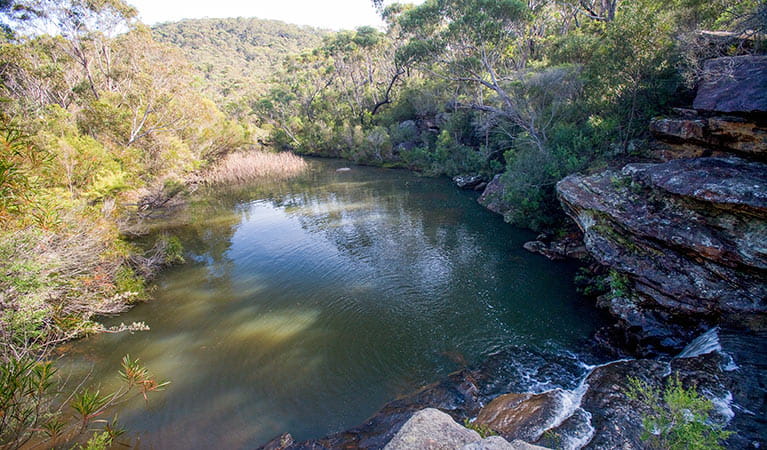
The area was for years home to local Aboriginal people, and you can still see several Aboriginal rock engraving sites. In 1937, a bushwalking group leased a section of what is now national parkland to protect this important area of bush. This section and its surrounds became known as the Heathcote Primitive Area (1943). This was expanded again and renamed Heathcote State Park (1967). In 1974, the area became Heathcote National Park.
The beauty of the bush
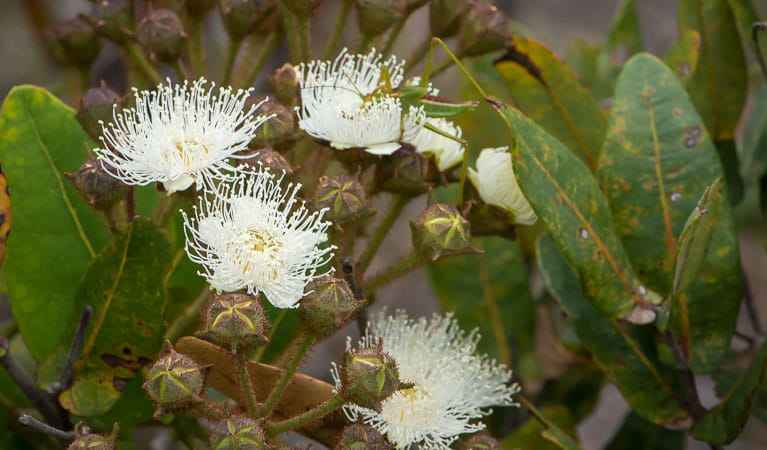
Heathcote National Park is a rugged landscape, flourishing with a variety of plants and animals. Eucalypts such as bloodwood, grey gum, Sydney peppermint, and scribbly gum dominate open forest areas alongside pockets of bright flowers like banksias, hakeas, and waxflowers, which are best enjoyed along a relaxing bushwalk. With so much plant life to admire, it’s no wonder wildlife like sugar gliders, ringtail possums and swamp wallabies also call Heathcote home. A soundtrack of chatty friar birds, honeyeaters and lyrebirds can also be heard across the park gorges during winter.
- Bullawarring walking track For great Sydney bushwalking, visit Heathcote National Park, near Waterfall in the Sutherland shire; combine your hike with birdwatching and freshwater swimming.
The great outdoors
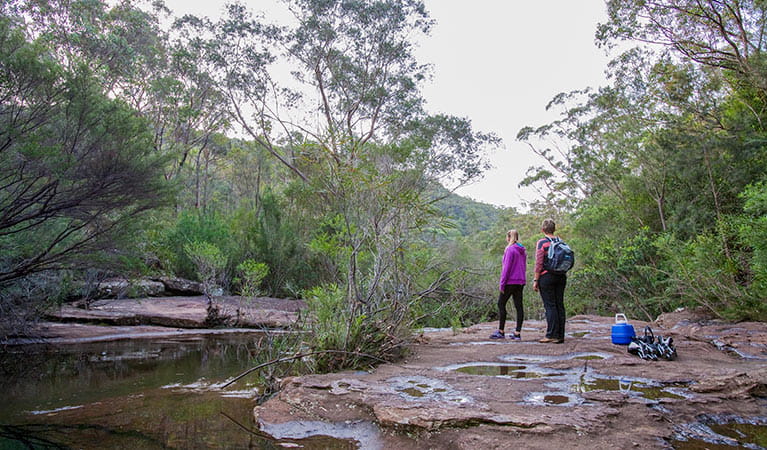
Slow down and forget your cares with a freshwater swim. Try Kingfisher Pool, Mirang Pool or Lake Eckersley. Or check out the pretty rockpools and waterfalls where Heathcote Creek meets the Woronora River. Cycle along Pipeline Road to the Sarahs Knob picnic area, where you can also complete a great hill run. The 2250ha park is less than an hour from central Sydney by car or train. The park adjoins Royal National Park, just west of the Princes Highway and South Coast train line. However, once you're inside you'll forget about transportation - the park is beautiful, quiet and secluded, plus, it's a vehicle-free zone. If you love to bushwalk, then Heathcote is your kind of park. A multitude of walking tracks criss-cross the park, including the Heathcote to Waterfall track linking Heathcote and Waterfall train stations.
- Kingfisher Pool picnic area A visit to this Sutherland picnic spot, located at Kingfisher Pool campground in Heathcote National Park, near Waterfall, offers birdwatching, bushwalking and swimming.
- Mooray walking track Enjoy a day of Sydney bushwalking and birdwatching. One of the best walks in Heathcote National Park, Mooray walking track is easily accessed from Waterfall train station.
Plants and animals protected in this park
Animals
-
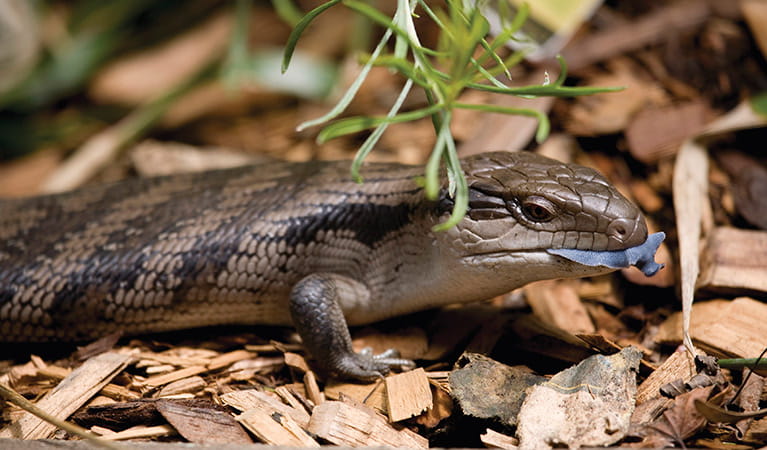
Eastern blue-tongue lizard (Tiliqua scinciodes)
The eastern blue-tongue lizard, one of the largest skinks in Australia, is found throughout most of NSW. When threatened, the eastern blue-tongue lizard displays its blue tongue in a wide-mouthed intimidating show. Not an agile animal, they feed on slow-moving beetles and snails.
-
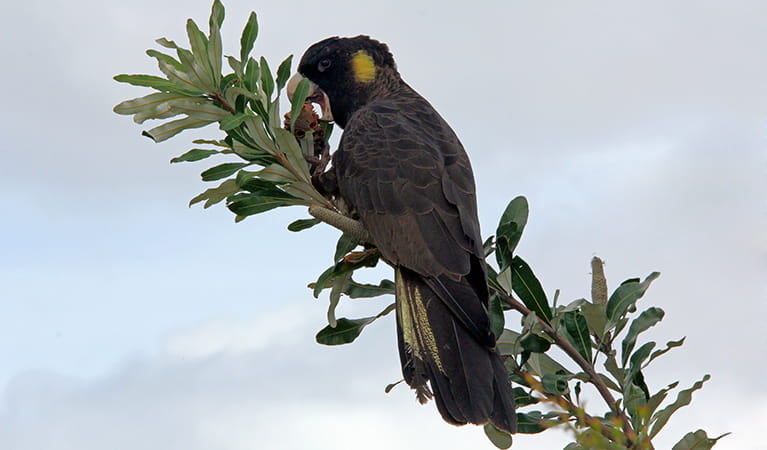
Yellow-tailed black cockatoo (Calyptorhynchus funereus)
The yellow-tailed black cockatoo is one of the largest species of parrot. With dusty-black plumage, they have a yellow tail and cheek patch. They’re easily spotted while bird watching, as they feed on seeds in native forests and pine plantations.
Plants
-

Grass tree (Xanthorrea spp.)
An iconic part of the Australian landscape, the grass tree is widespread across eastern NSW. These Australian native plants have a thick fire-blackened trunk and long spiked leaves. They are found in heath and open forests across eastern NSW. The grass tree grows 1-5m in height and produces striking white-flowered spikes which grow up to 1m long.
-
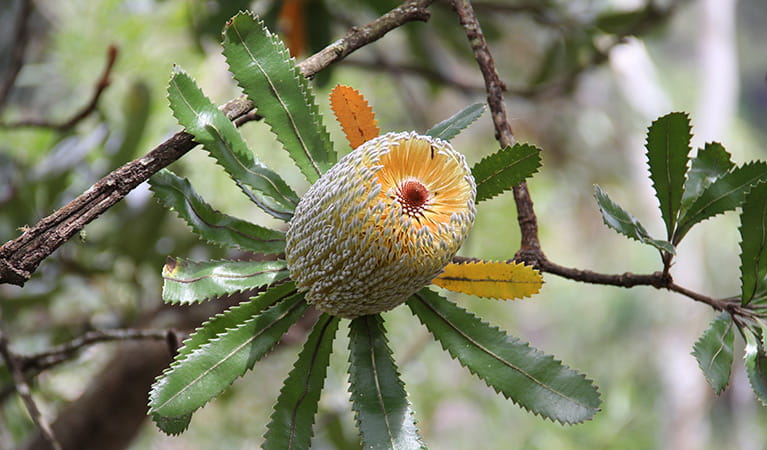
Old man banksia (Banksia serrata)
Hardy Australian native plants, old man banksias can be found along the coast, and in the dry sclerophyll forests and sandstone mountain ranges of NSW. With roughened bark and gnarled limbs, they produce a distinctive cylindrical yellow-green banksia flower which blossoms from summer to early autumn.
-
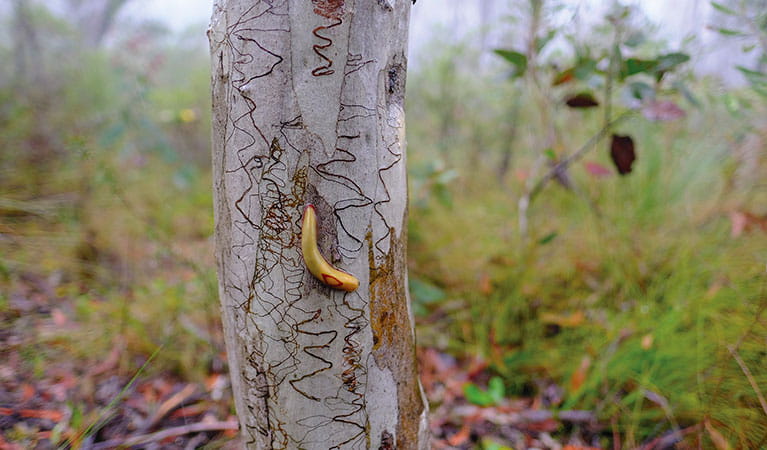
Scribbly gum (Eucalyptus haemastoma)
Easily identifiable Australian native plants, scribbly gum trees are found throughout NSW coastal plains and hills in the Sydney region. The most distinctive features of this eucalypt are the ‘scribbles’ made by moth larva as it tunnels between the layers of bark.
Environments in this park
Education resources (1)
General enquiries
- National Parks Contact Centre
- 7am to 7pm daily
- 1300 072 757 (13000 PARKS) for the cost of a local call within Australia excluding mobiles
- parks.info@environment.nsw.gov.au
Operated by
- Royal National Park Visitor Centre
- 8.30am to 4.30pm daily. Closed Christmas Day.
- 02 9542 0648
- 1300 072 757 for campground and cottage bookings
- npws.royal@environment.nsw.gov.au
- 2 Lady Carrington Drive, Audley, NSW 2232
Park info
- in Heathcote National Park in the Sydney and surrounds and South Coast regions
Heathcote National Park is open sunrise to sunset but may have to close at times due to poor weather or fire danger.
What's nearby:
Things to do (65)
- Aboriginal culture (3)
- Birdwatching and wildlife encounters (19)
- Cafes and kiosks (2)
- Canoeing/paddling (9)
- Cycling (6)
- Fishing (6)
- Historic heritage (2)
- Horse riding (1)
- Other experiences (3)
- Photography (1)
- Picnics and barbecues (24)
- Sailing, boating and cruises (2)
- Sightseeing (21)
- Surfing (1)
- Swimming (8)
- Visitor centres (1)
- Walking (30)
- Waterfalls (7)
- Waterhole (1)
- Wildflowers (seasonal) (6)

